by Bruce Wells | Feb 3, 2025 | This Week in Petroleum History
February 3, 1868 – Refiners seek End Civil to War Tax –
Angry refiners from Oil Creek, Pennsylvania, met in Petroleum Center and passed a resolution demanding an end to then U.S. “war tax” of one dollar per 42-gallon barrel of refined petroleum products, including kerosene. During the Civil War, Treasury Secretary Salmon P. Chase advocated petroleum taxes as high as $10.50 per barrel. A one-dollar excise tax on oil (per barrel) was imposed in 1864 and repealed in 1872 with most other war taxes — except whiskey.
February 4, 1910 – Showman “Buffalo Bill” explores for Wyoming Oil
Col. William F. “Buffalo Bill” Cody’s legacy extends beyond his famous Wild West Show — reaching into the Wyoming oil patch. Cody, who in 1896 founded the town that bears his name, in February 1910 bought 7,500 shares of an exploration venture he had formed with a congressman. It was not their first attempt to strike oil.
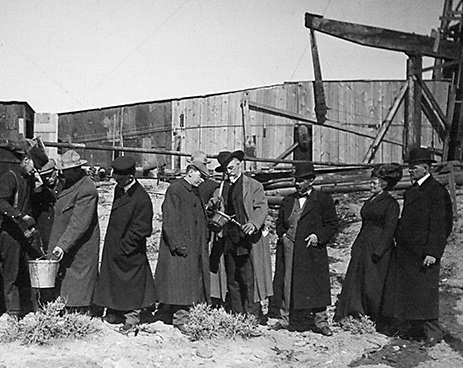
W.F. “Buffalo Bill” Cody, center in black hat, and other investors at an oilfield on the Shoshone Anticline near Cody, Wyoming, around 1910. Photo courtesy the American Heritage Center, University of Wyoming.
In 1902, Cody and several partners, including Wyoming Rep. Frank Mondell, began exploring near Cody. They drilled one 500-foot-deep dry hole and a second well also failed to find oil before they ran out of money. Cody and the congressman ventured into the oil business again in 1910 by forming the Shoshone Oil Company.
During a visit to New York City, Cody carried pocket flasks of oil to impress investors. His friends started calling him, “Bill the Oil King,” noted one historian, adding, “With what degree of seriousness we cannot know.”
Learn more in Buffalo Bill Shoshone Oil Company.

February 4, 1920 – Breckenridge Field joins North Texas Oil Boom
The No. 1 Chaney well tapped another giant oilfield in North Texas, which three years earlier had made headlines for its “Roaring Ranger” well in Eastland County. The latest discovery within the city limits of Breckenridge in Stephens County produced 3,700 barrels of oil per day.
“This started an intensive town block drilling campaign, and soon every block had its oil rig. Over 200 wells were drilled on the townsite, and most of them were good producers,” noted a 1930 report. “Owners of very small plots were made wealthy. By 1923, over 2,000 derricks surrounded Breckenridge within a radius of four miles.”
As the North Texas drilling boom continued, Breckenridge acquired its first railroad connection to Wichita Falls, Ranger and Fort Worth, soon joined by the Cisco and Northeastern line (see Oil Boom Brings First Hilton Hotel).
February 5, 1873 – Death of an Illegal Oil Well Shooter
Andrew Dalrymple, allegedly a frequent “moonlight oil well shooter” in the Tidioute, Pennsylvania, region, was killed in a nitroglycerin explosion at his home on Dennis Run, the Titusville Morning Herald reported. Supplies of nitroglycerin lately had been stolen from magazines throughout the oil region by those seeking to avoid fees for using the Roberts torpedo. “This species of theft is winked at by some parties, who are opposed to the Roberts torpedo patent,” the newspaper noted.
February 5, 1998 – DOE privatizes Elk Hills Petroleum Reserve
The Department of Energy and Occidental Petroleum concluded the largest divestiture of federal property in U.S. history with the sale of Elk Hills Naval Petroleum Reserve in Kern County, California. As the highest corporate bidder, Occidental ended the government’s business operations of oil and natural gas production at the 75-square-mile reserve. The $3.65 billion DOE divestment completed a privatization process that had begun years earlier.
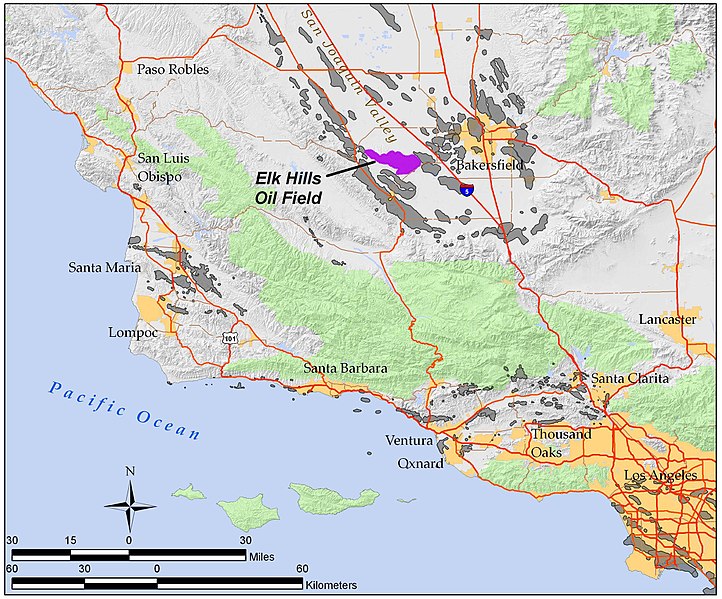
The California Resources Corporation (CRC) in 2018 acquired the former Naval Petroleum Reserve No. 1 in Kern County. California. Map courtesy Wikimedia Commons.
The Clinton Administration in May 1995 had proposed placing the federally-owned Elk Hills reserve on the market in an effort “to reduce the size of government and return inherently non-federal functions to the private sector,” according to the DOE Office of Fossil Energy.
Discovered in 1911 and designated America’s first oil preserve one year later, Elk Hills returned to production following the 1973 oil crisis, becoming one of the top ten most productive U.S. fields. The former Naval Petroleum Reserve No. 1 — made famous by the 1922 “Teapot Dome Scandal” during the Harding administration — was acquired by California Resources Corporation (CRC) in 2018.

February 7, 1817 – First Gas Street Light
Fueled by manufactured gas (distilled from tar and wood), America’s first public street lamp illuminated Market Street in Baltimore, making Gas Light Company of Baltimore the first U.S. commercial gas lighting company. City officials erected a replica of the lamp in 1997.

The first U.S. gas street lamp illuminated Baltimore in 1817. Photo courtesy BG&E.
Artist Rembrandt Peale earlier demonstrated the brightness of manufactured gas with a “ring beset with gems of light” at his Baltimore museum. “During a candlelit period in American history, the forward-thinking Peale aimed to form a business around his gas light innovations — and the exhibition targeting potential investors,” notes Baltimore Gas & Electric (BG&E), which began as the Gas Light Company of Baltimore.
Learn more in Illuminating Gaslight.
February 8, 1836 – Coal Gas brightens Philadelphia
As Philadelphia became America’s center for finance and industry, a municipally owned gas distribution company began lighting Second Street. The newly formed Philadelphia Gas Works ignited 46 lamps that burned manufactured coal gas. In Washington, D.C., manufactured gas began replacing kerosene lamps in the U.S. Capitol by 1847.

A manufactured gas storage facility at Point Breeze in South Philadelphia, circa 1856. Photograph courtesy Philadelphia Gas Works.
Philadelphia Gas Works in 1856 completed construction of a manufactured gas storage tank with a total capacity of 1.8 million cubic feet, the largest in America at the time. The village of Fredonia, New York, began the first commercial use of natural gas as early as 1825.

February 9, 2013 – Curiosity drills on Mars
Images transmitted from NASA’s robotic rover Curiosity confirmed it successfully drilled on the Martian surface, accomplishing “history’s first ever drilling and sampling into a pristine alien rock on the surface of another planet in our solar system,” according to Universe Today.
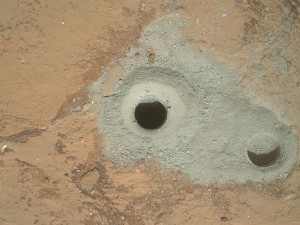
Mars rover Curiosity tested its rotary-percussion bit by making a shallow hole before drilling the first well on another planet. Photo courtesy NASA/JPL.
While exploring the Red Planet’s Yellowknife Bay Basin, Curiosity paused to drill for the first time, making a hole .63 inches wide and 2.5 inches deep. A rotary-percussion drill bit at the end of a seven-foot robotic arm penetrated a “red slab of fine-grained sedimentary rock with hydrated mineral veins of calcium sulfate.”

Curiosity’s “rotary-percussion” bit measured .6 of an inch wide. Photo courtesy NASA/JPL.
Images beamed from the site included a drill test next to the historic borehole. After completing Mars No. 1 (unofficial name), the one-ton rover drilled many others using its slow, “low-percussion” technique. Learn about terrestrial drilling methods in Making Hole – Drilling Technology.
_______________________
Recommended Reading: Around Titusville, Pennsylvania, Images of America (2004); Western Pennsylvania’s Oil Heritage
(2004); Western Pennsylvania’s Oil Heritage (2008); Presenting Buffalo Bill: The Man Who Invented the Wild West
(2008); Presenting Buffalo Bill: The Man Who Invented the Wild West (2016); In Pursuit of Fame: Rembrandt Peale, 1778-1860 (1993); Mars Rover Curiosity: An Inside Account from Curiosity’s Chief Engineer
(2016); In Pursuit of Fame: Rembrandt Peale, 1778-1860 (1993); Mars Rover Curiosity: An Inside Account from Curiosity’s Chief Engineer (2017). Your Amazon purchase benefits the American Oil & Gas Historical Society. As an Amazon Associate, AOGHS earns a commission from qualifying purchases.
(2017). Your Amazon purchase benefits the American Oil & Gas Historical Society. As an Amazon Associate, AOGHS earns a commission from qualifying purchases.
_______________________
The American Oil & Gas Historical Society (AOGHS) preserves U.S. petroleum history. Please become an AOGHS annual supporter and help maintain this energy education website and expand historical research. For more information, contact bawells@aoghs.org. Copyright © 2025 Bruce A. Wells. All rights reserved.
by Bruce Wells | Nov 11, 2024 | This Week in Petroleum History
November 11, 1884 – Gas Companies merge into Con Edison –
The largest U.S. gas utility company at the time was created in New York City when six gas-light companies — using manufactured coal gas — combined to form the Consolidated Gas Company. The Consolidated Edison Company, “Con Ed,” began six decades earlier as the New York Gas Light Company, which received a charter from the state legislature in 1823.

“Bird’s-eye view” illustrates New York and Brooklyn in 1873. The Brooklyn Bridge, then under construction, can be seen at the right. Image courtesy Library of Congress.
Like most early manufactured gas companies, New York Gas Light focused early efforts on public street lighting (see Illuminating Gaslight), replacing whale oil lamps installed by the city beginning in the 1760s.
Prior to the 1884 merger of the competing companies, streets often were being torn up by competing workmen installing or repairing their own company’s lines — and removing those of a rival. “Sometimes these work crews would meet on the same street and brawl, giving rise to the term “gas house gangs.”
Learn more in History of Con Edison.

November 11, 1926 – Route 66 officially commissioned
Five years after the Federal Aid Highway Act of 1921, U.S. Highway 66 was commissioned as a major thoroughfare in the national highway system. America’s “Mother Road” from Chicago to Los Angeles connected rural and urban communities along its almost 2,500 miles — until the interstate system incrementally replaced it.
Extended from Los Angeles to Santa Monica in 1935, Route 66 lost its highway status 50 years later when the American Association of State Highway and Transportation Officials officially decertified it. In 2019, Oklahoma established the Route 66 Centennial Commission, assisted by the Oklahoma Historical Society, to plan events celebrating the historic highway’s centennial in 2026.
November 12, 1899 – New York World features Mrs. Alford and her Nitro Factory
An 1899 article in the New York World profiled Mrs. Byron Alford — the “Only Woman in the World who Owns and Operates a Dynamite Factory.”

A laminated (though wrinkled) newspaper page from 1899 was part of a school project of a Mrs. Alford descendant, according to the Penn-Brad Oil Well Park and Museum in Bradford, Pennsylvania.
Mrs. Alford’s dangerous business operated on five acres outside of Bradford, Pennsylvania, with a daily production of 3,000 pounds of nitroglycerin and 6,000 pounds of dynamite. Local drillers used the explosives for “shooting” wells to boost production.
The article noted “the astute businesswoman” manufactured her volatile mixtures in 12 separate buildings, all made of wood and unpainted.
Learn more in Mrs. Alford’s Nitro Factory.
November 12, 1916 – Forest Oil Company formed
Forest Oil Company incorporated and began operations in the Bradford oilfield of northern Pennsylvania. The company, after adopting a “yellow dog” lantern logo, launched an important new technology: water-flooding (injecting water into oil-bearing formations) to stimulate production from depleted wells.
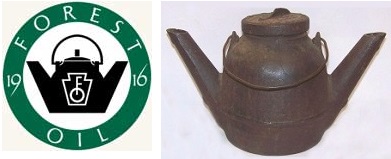
Forest Oil’s “yellow dog” lantern logo beside the oilfield lantern.
Water-flooding technology for enhanced recovery spread throughout the petroleum industry – and extended many wells’ lives by as much as a decade.
After merging in 1924 with four independent oil companies (January Oil Company, Brown Seal Oil, Andrews Petroleum, and Boyd Oil), Forest Oil was headquartered in Denver before being acquired in 2014 by a privately held Houston company.
November 12, 1999 – Plastics designated Historic Landmark
The American Chemical Society designated the discovery of a high-density polyethylene process as a National Historic Chemical Landmark in a ceremony at the Phillips Petroleum Company in Bartlesville, Oklahoma. The oil company had entered the plastics business in 1951 after discovering a catalyst for creating solid polymers.
“The plastics that resulted — crystalline polypropylene and high-density polyethylene (HDPE) — are now the core of a multibillion-dollar, global industry,” the society noted. Among the first customers for Phillips Petroleum plastics was Wham-O, which used it to make Hula Hoops and Frisbees in the 1950s.

November 13, 1943 – Death during Secret WWII Drilling Project
Derrickhand Herman Douthit of Caddo Mills, Texas, died from a fall at Well Number 148 in England’s Sherwood Forest, where he was part of a top-secret group of Americans drilling to expand production from the Eakring field. The roughnecks of Sherwood Forest increased production faster than their British counterparts while working 12-hour shifts in four crews. “Rigs shut down for one shift for his funeral, then back to work,” recalled Lewis Dugger of Louisiana. Forty-one of the volunteers returned safely in March 1944. Douthit was buried near Cambridge with full military honors.
November 14, 1927 – Gasometer Explosion shakes Pittsburgh
Three natural gas containers — gasometers — exploded in Pittsburgh, producing “tremors such as might have been caused by a severe earthquake,” according to a 1927 report, which noted the deaths of 28 people and injury of more than 400.
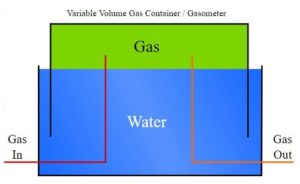
More often found in Europe, gasometers were replaced by high-pressure vessels for liquefied natural gas.
First used in the late 19th century for manufactured gas (and throughout the 20th century for natural gas), gasometers were large, cylindrical containers for storing gas at near atmospheric pressure at ambient temperatures. The volume of stored gas varied, with pressure added from the weight of a movable cap.
According to a 2006 Pittsburgh Magazine article, workmen had been using acetylene torches to repair a leak on top of a tank with a capacity of 5 million cubic feet of gas. Gasometers structures have been replaced by high-pressure vessels to store natural gas in liquid form (learn more in Horace Horton’s Spheres).
November 14, 1947 – First Oil Well drilled Out of Sight of Land
The modern offshore oil and natural gas industry began in the Gulf of Mexico with the first oil well successfully completed out of sight of land. Brown & Root Company built the experimental freestanding platform 10 miles offshore for Kerr-McGee and partners Phillips Petroleum and Stanolind. The platform, Kermac 16, was designed to withstand winds as high as 125 miles per hour.

The Kermac 16 platform was featured in a 1954 Bell Helicopter advertisement encouraging use of helicopters for offshore transportation.
After investing $450,000, Kerr-McGee completed the well in about 20 feet of water off Louisiana’s gradually sloping Gulf coast. The Kermac No. 16 well initially produced 40 barrels of oil per hour.
Kerr-McGee had purchased World War II surplus utility freighters and materials to provide supplies, equipment, and crew quarters for the drilling site at Ship Shoal Block 32. Sixteen 24-inch pilings were sunk 104 feet into the ocean floor to secure a 2,700-square-foot wooden deck. The Kermac No. 16 platform withstood several 1947 hurricanes and tropical storms.
Learn more about offshore technologies in Offshore Drilling History.
November 14, 1947 – WW II “Big Inch” and “Little Big Inch” Pipelines Sold
Texas Eastern Transmission Corporation, a company established 11 months earlier to acquire the World War II surplus 24-inch “Big Inch” and 20-inch “Little Big Inch” pipelines, won ownership of them with a bid of $143,127,000. It was America’s largest sale of war surplus material to the private sector.

War Emergency Pipelines, Inc., in 1942 began construction of the longest U.S. petroleum pipeline construction ever undertaken in the United States — two pipelines spanning 1,200 miles. Photo Courtesy Library of Congress.
By the 1950s, Texas Eastern Transmission converted both oil product pipelines to natural gas, which was needed for the Appalachian region. By the 2000s, transmission would become bi-directional for carrying natural gas from the Marcellus and Utica shale to mid-west markets. The Big Inch Pipelines of WW II were added to the National Register of Historic Places in 1998.
November 15, 1906 – Justice Department seeks Breakup of Standard Oil
U.S. Attorney General Charles Bonaparte filed suit to compel dissolution of Standard Oil of New Jersey. Despite an 1892 court decision ordering the Standard Oil Trust to be dissolved, John D. Rockefeller reorganized it and continued to operate from New York. The Justice Department won the latest suit and Standard Oil appealed to the U.S. Supreme Court, which affirmed the lower court’s decision on May 15, 1911, and mandated dissolution of Standard Oil into 34 separate companies.

November 15, 1952 – Williston Basin produces Millionth Barrel of Oil
The Williston Basin produced its millionth barrel of oil, which came from five fields in three counties in North Dakota, where Amerada Petroleum had launched a 1951 drilling boom northeast of Williston (see First North Dakota Oil Well). By the end of 1952, the Williston Basin’s production reached 356,000 barrels of oil a month.















